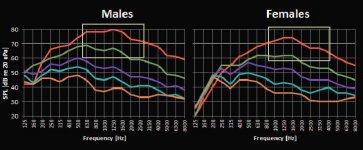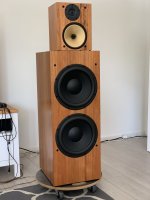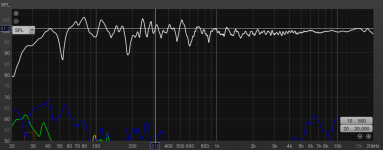Member
Joined 2003
The 8 ohm WF120BD04 is 86dB@2.83V. Keep it's operation > baffle step and it's good to use with woofers up to 91-92dB sensitivity given full 6dB of BSC.my plans are 300-2500hz. That is a reasonably priced mid. Its a bit inefficient in 8 ohm version at 84 db but thats fine. with contribution from woof and tweet it brings it up
Last edited:
This is one of these fallacies. I have a 3 way that currently is in prototype phase, via DSP and tri-amped.
crsoovers is 300Hz and 2-3K ; system is good enough sensitivity for most domestic uses (92dB/2.83V) and no major directivity mismatch.
I can click in/out the LF, the MF and HF all at the touch of a button. Take away the bass and treble and it really does sound like tinny telephone speaker. Bring bac the bass and it’s ok, it hmm missing something. Click a min try tweeter and the gloriousness comes back.
So you need everything.
but, if you take out most of what’s there above 10K and what’s below 50Hz using high and low pass filter; you’re not missing much.
I think that’s where music lives. Get the balance and dynamics right between 50Hz and 10KHz and you’re golden.
Those horn systems with 100dB/W are just startling convincing or real live music. No super tweeter or subwoofer required .
crsoovers is 300Hz and 2-3K ; system is good enough sensitivity for most domestic uses (92dB/2.83V) and no major directivity mismatch.
I can click in/out the LF, the MF and HF all at the touch of a button. Take away the bass and treble and it really does sound like tinny telephone speaker. Bring bac the bass and it’s ok, it hmm missing something. Click a min try tweeter and the gloriousness comes back.
So you need everything.
but, if you take out most of what’s there above 10K and what’s below 50Hz using high and low pass filter; you’re not missing much.
I think that’s where music lives. Get the balance and dynamics right between 50Hz and 10KHz and you’re golden.
Those horn systems with 100dB/W are just startling convincing or real live music. No super tweeter or subwoofer required .
^ thats basically my favourite analogy to wavelength, our size and our speakers size are midrange size 🙂
ATC SM75-150. Probably about as good as it gets.Ive decided that I want to upgrade and try the best sounding midrange I can find. what is the best sounding midrange you've worked with or heard....
my current mid is a peerless 830883 6 1/2 mid. hope to upgrade from this
Jim Bones, when you have the chance of a three way, try avoid any joints in the human voice spectra. If so, try find a driver that have a nice response up to 4k and possibly down to 700hz at the low end.
Troels have done a buildt on this sweet driver:
seas prestige h1304
https://www.madisoundspeakerstore.c...tige-mca12rc-h1304-4.5-coated-paper-midrange/
Troels have done a buildt on this sweet driver:
seas prestige h1304
https://www.madisoundspeakerstore.c...tige-mca12rc-h1304-4.5-coated-paper-midrange/
Attachments
Last edited:
What do you all think of the pro FaitalPro midranges in the 5 to 8" range? The specs seem really good with amazing power handling.
Human voice starts at 80 Hz. Midrange offically starts at 160 Hz.
I typically XO 200-400 hz. But that low is is possible to get the mid within a quarter wavelength at teh XO, if you choose drivers with similar voicing the XO cn be made fairly invisible, but the more voice you can get the better in respect to tha particualr asset. If that was the primary goal you would find a FR that gets down to 80 Hz sealed (good luck), and still has top that can rival a good tweeter.
Levels & dynamics may suffer.
dave
I typically XO 200-400 hz. But that low is is possible to get the mid within a quarter wavelength at teh XO, if you choose drivers with similar voicing the XO cn be made fairly invisible, but the more voice you can get the better in respect to tha particualr asset. If that was the primary goal you would find a FR that gets down to 80 Hz sealed (good luck), and still has top that can rival a good tweeter.
Levels & dynamics may suffer.
dave
But overall it is a very good point.
The modern world is full of some very good Full range drivers.
Which also make excellent midrange.
People kinda roll their eyes with price friendly drivers.
But they pack a lot of features these days.
Your seeing phase plugs, copper rings, exotic cone material, open cast frames
and a decade or so ago these would be extremely expensive drivers.
now many well around 30 dollars.
excellent midrange possibility's
anyways...there is numerous 3" or 4" Dayton Drivers
from glass fiber cones to aluminum.
Many with phase plugs, copper rings and open cast frames.
FRD files are easily had from the company.
So it makes a more detailed review in computer land.
The modern world is full of some very good Full range drivers.
Which also make excellent midrange.
People kinda roll their eyes with price friendly drivers.
But they pack a lot of features these days.
Your seeing phase plugs, copper rings, exotic cone material, open cast frames
and a decade or so ago these would be extremely expensive drivers.
now many well around 30 dollars.
excellent midrange possibility's
anyways...there is numerous 3" or 4" Dayton Drivers
from glass fiber cones to aluminum.
Many with phase plugs, copper rings and open cast frames.
FRD files are easily had from the company.
So it makes a more detailed review in computer land.
Been there, done that, don't agree, at least for LF. VHF us less an issue for me providing what's there is clean and not say the breakup of a 4" Ti diaphragm.No super tweeter or subwoofer required .
Spot on man. That's why the everyone (>90%) of the world now listen to 3-4" drivers in a $100 (or less) bluetooth speaker, or through their TV speakers or sound bars?But overall it is a very good point.
The modern world is full of some very good Full range drivers.
Which also make excellent midrange.
People kinda roll their eyes with price friendly drivers.
But they pack a lot of features these days.
Your seeing phase plugs, copper rings, exotic cone material, open cast frames
and a decade or so ago these would be extremely expensive drivers.
now many well around 30 dollars.
excellent midrange possibility's
anyways...there is numerous 3" or 4" Dayton Drivers
from glass fiber cones to aluminum.
Many with phase plugs, copper rings and open cast frames.
FRD files are easily had from the company.
So it makes a more detailed review in computer land.
Last edited:
Been there, done that, don't agree, at least for LF. VHF us less an issue for me providing what's there is clean and not say the breakup of a 4" Ti diaphragm.
Hi Brett,
Do you mind expanding on that?
Yeah I don't agree with the everyone (ie. 99%) of the world either. I'm in the 1% that thinks you need in-room response to 30Hz with 110dB @1m per speaker, with no distortion up to 100dB!
But we're all audio tragics here at DIYaudio. We are not NORMAL!
You know, my current speaker speaker sitting here has twin 12" woofers per side, and I have twin 15" subwoofers in room as well...
Attachments
Last edited:
There is no such thing. It is a myth made by boring people.NORMAL!
Here here! I agree and my personal design priorities are :Hi Brett,
Do you mind expanding on that?
Yeah I don't agree with the everyone (ie. 99%) of the world either. I'm in the 1% that thinks you need in-room response to 30Hz with 110dB @1m per speaker, with no distortion up to 100dB!
But we're all audio tragics here at DIYaudio. We are not NORMAL!
You know, my current speaker speaker sitting here has twin 12" woofers per side, and I have twin 15" subwoofers in room as well...
(1) Life like Dynamics - Ability to reproduce SPL's close to concert grand piano played live with no PA.
(2) Tonal accuracy - Sound mimics human voice and acoustic instruments if they were singing / played in your listening room... ie not in open air or an acoustically treated recording studio.
(3) Low distortion - Drivers operating well within their limits. ie no driver ever approaches more than 50% of its X max or thermal max.
Over the years (35 as a DIY speaker guy!) I have concluded that there is one overarching specification/design goal which governs these 3 priorities - Time Domain Accuracy. Get that right and everything else clicks into place.
Unfortunately I am now unable to listen to audiophile drivers and 99% of the high end speakers as they fail miserably in 1 or more of my 3 requirements.
I am currently experimenting with my own design trying to manufacture an "End Game" point source / coax incorporating multiple midrange drivers (5 to 6 inch) and a beast of an AMT tweeter. So far its sounding great but still in mule cabinets and using cheap / used test drivers.... Once its ready for prime time - end of year if I can save enough £££ I will make a thread on here.
Good luck to everyone pursuing your own design priorities Thats DIY!
PS As a dedicated midrange covering up to 80Hz to 800Hz band the (now sadly discontinued) Precision Devices PD 158 in 20 litre sealed box and with active crossover / DSP is easily the best I have ever used or heard. https://www.precision-devices.com/wp-content/uploads/2020/09/PD158-DATASHEET-310114.pdf
For sure! If you want to buy 20 pairs or more PD might do an OEM run... Group buy anyone?!ha ha I should have said "readily available "
Dave,Alpair 7 MAOP.
dave
Is it MAOP 7.2?
Do you have a data sheet for that driver? I don't find it.
Thanks!
I have seen MAOP 10.2, but as far as i know we still are at MAOP 7. I have a pair of those.
dave
dave
- Home
- Loudspeakers
- Multi-Way
- Music lives in the midrange


